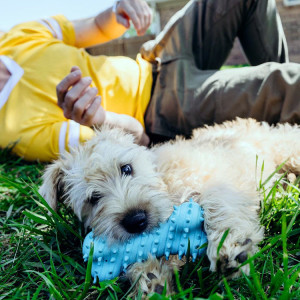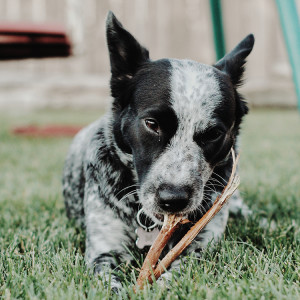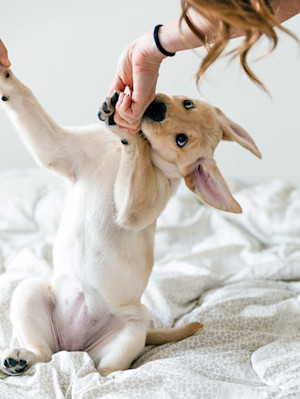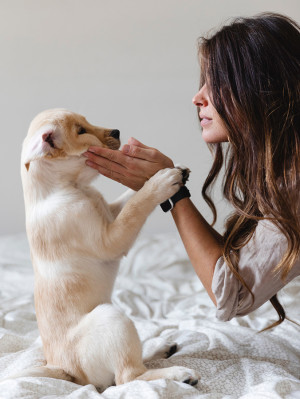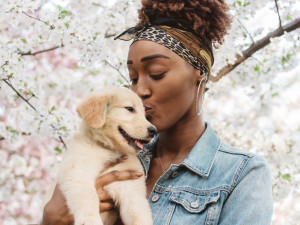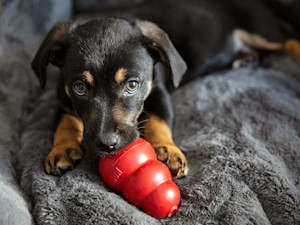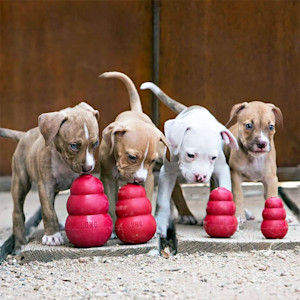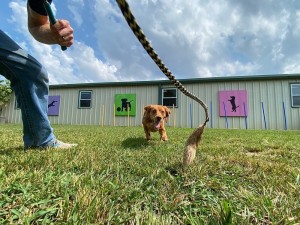Can Puppies Chew on Sticks?
Why they shouldn’t make a DIY chew toy out of the stuff in your yard.

Share Article
In This Article:
Why Do Dogs Chew Sticks? Safety Concerns How Do I Get My Puppy to Stop Eating Sticks? What Can Puppies Chew On? Frequently Asked Questions
While it’s a common sight to see puppies enthusiastically chewing on sticks, this natural behavior poses significant risks to their health and safety. From potential choking hazards to intestinal blockages and oral injuries, allowing puppies to chew on sticks is generally discouraged by vets.
Why do dogs chew sticks?
Dogs chew on sticks for a number of reasons including curiosity, boredom, and learned behavior. Puppies tend to explore their surroundings with their mouths, so it’s normal for puppies to chew on wood and sticks they find outside. Chewing can be a form of entertainment for dogs, so some dogs chew on sticks to alleviate boredom.
Some dogs just like the sensation of chewing on sticks. They may like the texture, weight of heavier sticks, or the crunch of the wood. It can be normal for a puppy to want to chew all the time, and chewing on sticks may soothe mouth pain in teething puppies.

Safety concerns
You’ve probably seen those cute videos online of dogs triumphantly carrying a stick that’s almost the size of a telephone pole. Although these videos are adorable, dogs chewing sticks is not the safest habit.
Chewing on sticks may be a natural behavior, but that doesn’t mean it’s safe. A “stick” can mean a variety of objects including small twigs, large branches, kebab skewers, and wood planks. Puppies may want to chew on any of these objects, but each comes with its own risk. Potential hazards of puppies chewing on sticks include:
Oral trauma
Sticks with sharp edges or splintered pieces can cause injuries to a puppy’s mouth such as punctures and lacerations. There have been many cases of dogs rushed to the ER due to a stick lodged between their teeth, causing both the pup and their parents to panic. Sometimes, it’s an easy fix, but other times, the stick damages the soft tissues in the mouth. This can put a puppy at risk for infection due to the bacteria present in both the mouth and the stick.
Dental trauma
If a stick is hard enough, it can break a puppy’s tooth. Losing a baby tooth too early can be painful for a puppy, even if the tooth was going to eventually fall out anyway. Breaking an adult tooth, however, often requires repair or removal and can lead to long-term dental issues.
Choking
Sticks can also be a choking hazard for puppies. A stick or splinter can become lodged in a puppy’s airway and cause breathing difficulties.
Intestinal blockages
Some pups only chew on sticks, but others take it a step further and actually eat them. Swallowed sticks can get lodged in the esophagus, stomach, or intestines. If a puppy swallows a tiny twig, stomach acid might soften it so it passes through the intestinal tract without a problem. However, if your pup swallows a sharp stick, or it zigs instead of zags during digestion, it can puncture the intestinal wall, leading to leakage and a serious infection.
Toxicity
Puppies can develop toxicity from chewing on sticks, depending on the source. Chewing on moldy wood can expose a puppy to harmful fungi. Sticks treated with pesticides, fertilizers, or other chemicals can also pose a threat if ingested. The type of wood itself can be a factor. Certain trees, like black walnut trees, are toxic to dogs and can cause symptoms like vomiting and muscle tremors.
When to seek veterinary care for excessive chewing behaviors
If your puppy chews your favorite pair of shoes, that’s a major annoyance. If your puppy constantly chews and eats everything in sight, that may be a sign of an underlying health issue. Pica is the persistent chewing and eating of things that aren’t food. Puppies can develop pica due to medical conditions, like nutritional deficiencies, or behavioral issues, like anxiety.
If your puppy insists on constantly eating sticks or other non-food items, have a chat with your vet. If your puppy chews on sticks outside, watch for issues. Signs that chewing on sticks is causing your puppy harm include:
Mouth pain
Bleeding from the mouth
Gagging
Excessive drooling
Trouble swallowing
Vomiting
Abdominal pain
Straining to defecate
How do I get my puppy to stop eating sticks?
Many vets would advise that it isn’t OK for puppies to chew on wood, so how can puppy parents curb this behavior? Here are some tips to get your puppy to stops chewing on sticks:
Don’t encourage the behavior.
Playing fetch outside can be a fun bonding activity for you and your puppy, but be sure to give your puppy appropriate items to retrieve. Allowing sticks during playtime and then later making them off-limits sends mixed signals and can confuse your puppy.
Limit access to sticks
If your puppy is going through a super mouthy phase and grabs everything they see, try walking them in areas with less vegetation and fewer distractions. Remove tempting sticks and twigs from your yard to reduce the chances of your puppy chewing on them.
Teach your puppy to “drop it”
“Drop it,” or a similar cue, like “leave it” or “release,” is a helpful tool to provide safety and control in potentially dangerous situations, especially if your puppy picks up something toxic. This cue prompts your puppy to let go of an item right away, preventing them from trying to play with it or swallow it.
Provide safe alternatives
Chewing is a natural behavior for puppies. Puppy parents can discourage their pup from chewing on sticks by providing other options, like a chew toy they won’t choke on. Please always remember to supervise your dog no matter what.
What can puppies chew on?
Puppy parents can provide chew toys to help ease teething or rambunctious puppies. Puppy chew toys should be appropriate in size — not small enough to swallow whole and not so big that the puppy can’t actually chew on it. Chew toys should not be hard enough to break teeth and should not break into pieces, despite a puppy’s best efforts. Providing safe toys to address puppy boredom reduces the risks of choking, tooth damage, or intestinal blockage. Puppies should be supervised with a new toy.
Can puppies chew on bully sticks?
Bully sticks are made of dehydrated bull penis and are popular chew treats for some dog parents. Bully sticks are rock-hard and too strong for puppy teeth. Bully sticks can be beneficial for some adult dogs, including removing plaque, but bully sticks are not without risk.
Bully sticks can fracture teeth and cause GI upset. Small pieces can be choking hazards or get stuck in the intestinal tract. There are safer options than bully sticks for puppies. If you opt to give your pup a bully stick, wait until they have all their adult teeth (at least six months old) and don’t let them have one unsupervised.
FAQs (People also ask):
Can puppies lose their teeth?
Puppies can naturally lose their teeth. Dogs have two sets of teeth — baby teeth and adult teeth. Puppies can and should start losing their baby teeth around three months of age, and have a full set of adult teeth around six months.
What are the best chew bones for puppies?
The best chew bones for puppies are durable and designed to be chewed, not broken to pieces and eaten. Puppies should not have bones that splinter like chicken bones or treats that are hard enough to break their teeth like bully sticks.
Can puppies choke on chew sticks?
Puppies can choke on chew sticks if they break off large pieces or try to swallow the chew stick whole. Puppies should be supervised when given chew sticks and toys to prevent accidents.
References:

Dr. Alycia Washington, DVM, MS
Alycia Washington is a small-animal emergency veterinarian with over 10 years of experience based in North Carolina. She works as a relief veterinarianopens in new tab and provides services to numerous emergency and specialty hospitals. She also works as a veterinary writer with a focus on educating pet parents.
Related articles
When Can a Puppy Eat Solid Food?
Yes, a question that also applies to human babies.
![Woman playing with her puppy.]()
Can Puppies Lose Their Teeth? Baby Teeth In Puppies
Whether you should save them for the tooth fairy is another issue entirely.
![Woman playing with a puppy at home.]()
At What Age Can Puppies Have Bully Sticks?
They do like to use those chompers, but is this a safe alternative to your fingers?
![woman draped in an orange blanket holds a black-and-white puppy]()
5 Development Stages You Should Know When You Get a Puppy
It’s like What to Expect When You’re Expecting, except add “four little paws to run around your house” to the title.
![A Terrier Puppy With Spots And Big Ears Chews On Their Paws.]()
Why Do Dogs Chew Their Paws?
And when will it stop?
![Small black puppy chewing on a Kong toy.]()
What to Do (and Not Do) When Your Puppy Is Teething
When those little razors start biting, keep these tips in mind.
![Bullmastiff puppy chewing on a purple ring chew toy]()
11 Tough Toys for Power Chewers
Veterinary behaviorist Dr. Valli Parthasarathy reccos the most durable dog toys for destructive players.
![Dog in the grass outside chewing on a bully stick]()
Chew on This: A Guide to Safe and Not-So-Safe Dog Bones
Two experts—a veterinary dentist and internist—rate the most popular dog bones.
![four puppies teeth on red Kongs]()
Best Teething Puppy Toys of 2025: Chews, Treats and More
Because your favorite chair is not a chew toy.
![Golden Retrieve dog running in the grass outside, playfully chasing a flirt pole held by a man in blue jeans]()
How to Tell if Your Dog Is Bored
Get out the toys and puzzles.

